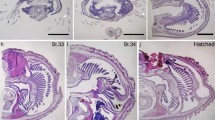Summary
Primary cultures of circulatory blood cells from the colonial tunicateBotryllus schlosseri were cultivated in 96-well plates for up to 3 mo. in a medium based on Dulbecco’s modified Eagle’s medium, supplemented with salts to the botryllid ascidian hemolymph osmolarity, HEPES buffer,l-glutamin, fetal bovine serum, and antibiotics. Intercellular bridges between granular pigment cells were established within 24 h. The viability of these cells decreased slowly, and most died within 1 mo. without any sign of cell proliferation. Other cell types remained in an arrested state and were subjected to a weekly medium exchange. Spontaneous cell proliferation was randomly recorded in 6 to 10% of the wells from 2 wk to 1 mo. This proliferation was followed by the formation of masses of cell clumps, from which uniform hemocytes (5 µm, lymphocytelike cells) migrated peripherally. Stress conditions, which included longer intervals between medium exchanges and partial medium replacement, increased the probability of cell proliferation. From each proliferating primary culture, we successfully performed up to 10 plating cycles over a period of 15 wk, during which the cells differentiate in size but are uniformly structured. This produced the firstBotryllus lymphocytelike cell line. From this stage, cell numbers remained constant for up to 6 mo. without increase in cell number. Several mitogenic factors were employed on primary cultures.Botryllus and sea cucumber hemolymphs and mixed interleukins were found to augment significantly proliferation of at least one specific cell size, whereas cells were not markedly responsive to lectins (Concavalin A, wheat germ agglutinin,Ulex europaeus agglutinin), insulin, and retinoic acid. The results are discussed with respect to future efforts in the development of tunicate blood cell cultures.
Similar content being viewed by others
References
Beck, G.; O’Brien, R. F.; Habicht, G. S. Invertebrate cytokines: the phylogenetic emergence of interleukin-1. BioEssays 11:62–67; 1989.
Berrill, N. J. The origin of vertebrates. New York: Oxford University Press; 1955.
Boyd, H. C.; Brown, S. K.; Harp, J. A., et al. Growth and sexual maturation of laboratory cultured MontereyBotryllus schlosseri. Biol. Bull. 170:91–109; 1986.
Boyd, H. C.; Weissman, I. L.; Saito, Y. Morphologic and genetic verification that MontereyBotryllus and Woods HoleBotryllus are the same species. Biol. Bull. 178:239–250; 1990.
Coombe, D. R.; Ey, P. L.; Jenkin, C. R. Particle recognition by haemocytes from the colonial ascidianBotrylloides leachi: evidence that theB. leachi HA-2 agglutinin is opsonic. J. Comp. Physiol. B 154:509–521; 1984.
Ermark, T. H. An autoradiographic demonstration of blood cell renewal inStyla clava (Urochordata: Ascidiacea). Experientia 31:837–839; 1975.
Ermark, T. H. The renewing cell populations of ascidians. Am. Zool. 22:795–805; 1982.
Ferkovich, S. M.; Oberlander, H. Growth factors in invertebratein vitro culture. In Vitro Cell. Dev. Biol. 27:483–486; 1991.
Freeman, G. The reticuloendothelial system of tunicates. J. Reticuloendothel. Soc. 7:183–194; 1970.
Goodbody, I. The physiology of ascidians. Adv. Mar. Biol. 12:1–149; 1974.
Grace, T. D. C. Establishment of four strains of cells from insect tissues grownin vitro. Nature 195:788–789; 1962.
Grace, T. D. C. The morphology and physiology of cultured invertebrate cells. In: Vago, C., ed. Invertebrate tissue culture, vol. 1. New York: Academic Press; 1971:171–209.
Grace, T. D. C. Development of insect cell culture. In: Maramorosch, K.; Mitsuhashi, J., eds. Invertebrate cell culture applications. New York: Academic Press; 1982:1–8.
Harp, J. A.; Tsuchida, C. B.; Weissman, I. L., et al. Autoreactive blood cells and programmed cell death in growth and development of protochordates. J. Exp. Zool. 247:257–262; 1988.
Lynn, D. E. Methods for the development of cell lines from insects. J. Tissue Cult. Methods 12:23–29; 1989.
Milanesi, C.; Burighel, P. Blood cell ultrastructure of the ascidianBotryllus schlosseri. I. Hemoblast, granulocytes, morula cells and nephrocytes. Acta Zool. 59:135–147; 1978.
Milkman, R. Genetic and developmental studies ofBotryllus schlosseri. Biol. Bull. 132:229–243; 1967.
Raftos, D.; Stillman, D. L.; Cooper, E. L.In vitro culture of tissue from the tunicateStyela clava. In Vitro Cell. Dev. Biol. 26:962–970; 1990.
Rinkevich, B.; Weissman, I. L. Chimeras in colonial invertebrates: a synergistic symbiosis or somatic and germ cell parasitism. Symbiosis 4:117–134; 1987.
Rosenthal, J.; Diamant, A.In vitro primary cell cultures fromPenaeus semisulcatus. In: Perkins, F. O.; Cheng, T. C., eds. Pathology in marine science. San Diego: Academic Press; 1990:7–13.
Sabbadin, A. Studio sulle cellule del sangue diBotryllus schlosseri (Pallas) (Ascidiacea). Arch. It. Anat. Embriol. 60:33–67; 1955.
Sabbadin, A.; Zaniolo, G. Sexual differentiation and germ cell transfer in the colonial ascidianBotryllus schlosseri. J. Exp. Zool. 207:289–304; 1979.
Schlumpberger, J. M.; Weissman, I. L.; Scofield, V. L. Separation and labeling of specific subpopulations ofBotryllus blood cells. J. Exp. Zool. 229:401–411; 1984.
Scofield, V. L.; Schlumpberger, J. M.; West, L. A., et al. Protochordate allorecognition is controlled by a MHC-like gene system. Nature 295:499–502; 1982.
Sugino, Y. M.; Ishikawa, M. The intercellular bridge of a blood cell in the ascidianCiona savignyi. Zool. Sci. 6:599–602; 1989.
Warr, G. W.; Decker, J. M.; Mandel, D. D., et al. Lymphocyte-like cells from the tunicatePyura stolonifera: binding of lectins, morphological and functional studies. Aust. J. Exp. Biol. Med. Sci. 55:151–164; 1977.
Wright, R. K. Urochordates. In: Ratcliffe, N. A.; Rowley, A. F., eds. Invertebrate blood cells, vol. 2. London: Academic Press; 1981:565–625.
Author information
Authors and Affiliations
Rights and permissions
About this article
Cite this article
Rinkevich, B., Rabinowitz, C. In vitro culture of blood cells from the colonial protochordateBotryllus schlosseri . In Vitro Cell Dev Biol - Animal 29, 79–85 (1993). https://doi.org/10.1007/BF02634375
Received:
Accepted:
Issue Date:
DOI: https://doi.org/10.1007/BF02634375




